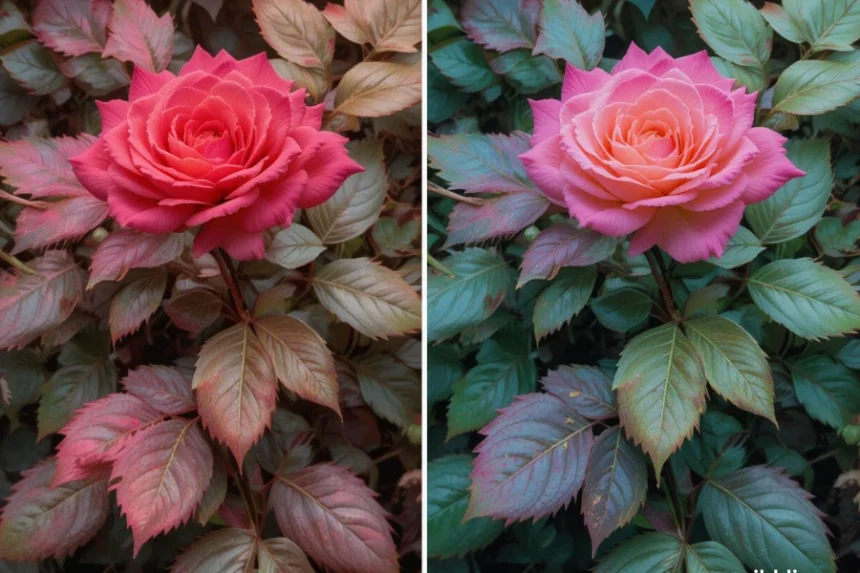Introduction to Rose Foliage Color Changes
One of the most popular blooming plants, roses are prized for their exquisite flowers and captivating scent. However, beyond their beautiful flowers, the foliage of rose plants also plays a vital role in their overall aesthetic appeal. One intriguing aspect that often captivates gardeners and horticulturists alike is the rose foliage color changes. These transformations in leaf color not only signal the plant’s health and adaptability but also add a dynamic visual interest throughout the year.
What Causes Rose Foliage Color Changes?
Several factors influence the rose foliage color changes, including environmental conditions, plant genetics, and seasonal variations. Understanding these underlying causes can help gardeners maintain healthy roses and appreciate their evolving beauty.
Environmental Factors
Environmental elements significantly impact leaf coloration. Temperature fluctuations cause chlorophyll degradation, revealing other pigments like carotenoids and anthocyanins. For example, cooler temperatures in fall prompt red or purple hues, while hot summer days may enhance yellowing or bronzing of leaves.
Sunlight Exposure
Sunlight exposure is a major determinant of foliage color. Roses grown in full sun tend to have darker green, more vibrant leaves. Conversely, shaded roses might develop lighter foliage, sometimes with a bluish or yellowish tint. Additionally, increased sunlight can trigger the production of anthocyanins, leading to reddish or purple leaf tones.
Soil Conditions
Soil pH and nutrient levels influence leaf pigmentation. A deficiency in nutrients like nitrogen often causes leaves to turn yellow, while excess copper or phosphorus might induce purple or blue-green hues. Proper soil management ensures that foliage remains healthy and displays its natural color spectrum.
Plant Genetics and Varieties
Certain rose varieties are naturally predisposed to exhibit striking foliage color changes. For instance, some shrub roses or hybrid teas display deep green leaves that turn red or bronze in cooler weather. Some cultivars are specifically bred for their ornamental foliage, showcasing intentional color variations.
Seasonal Variations in Rose Foliage Color
Seasonal variations in color of rose leaf provide a vibrant show all year long.
Spring
In spring, rose leaves are typically bright and fresh green as the plant emerges from dormancy. This vivid color represents fresh development well-being. Some varieties may develop reddish or copper tones early in the season, adding a splash of color.
Summer
In summer, leaves typically turn a rich, deep green. However, intense sunlight and heat can cause some leaves to develop a bronzed or slightly yellowish tint. Proper watering and shading can help maintain lush foliage during hot months.
Fall
Fall is perhaps the most dramatic time for rose foliage color changes. Cooler temperatures and shorter days often induce leaves to turn red, crimson, orange, or purple. These vibrant shades provide an added visual delight, making fall an excellent time for ornamental display.
Winter
In winter, many roses shed their leaves, especially deciduous types. However, some hardy or evergreen roses retain their foliage, which may turn reddish-brown or bronze before eventual leaf drop. The remaining leaves may also display muted colors, emphasizing the plant’s structural form.
Recognizing Healthy vs. Unhealthy Foliage Color Changes
While natural seasonal shifts are expected, abnormal foliage color changes can indicate underlying issues.
Signs of Healthy Foliage Color Changes
- Gradual color transition aligned with seasonal patterns.
- Leaf colors are vibrant but natural-looking.
- No signs of spots, mold, or discoloration.
- Consistent foliage growth with healthy appearance.
Signs of Unhealthy Foliage Color Changes
- Sudden or patchy discoloration.
- Leaves turning yellow, brown, or black unexpectedly.
- Presence of spots, mildew, or pests.
- Wilting or curling leaves.
If such symptoms appear, it’s essential to review care practices, such as watering, fertilization, and pest control.
Tips to Enhance and Maintain Beautiful Rose Foliage
To ensure your roses display their best foliage color changes, consider these tips:
Provide Adequate Sunlight: The majority of roses require at least six hours of direct sunlight per day to flourish.
Maintain Proper Watering: Avoid overwatering or underwatering, as stress can affect foliage color.
Fertilize Appropriately: Use balanced fertilizers to provide necessary nutrients, especially nitrogen.
Prune Regularly: Remove dead or diseased leaves to promote healthy growth and vibrant coloration.
Protect from Pests and Diseases: Keep an eye out for common pests that can damage leaves and alter their color.
The Artistic Appeal of Foliage Color Changes
Beyond the botanical significance, rose foliage color changes add an artistic element to gardens and landscapes. The shifting hues can complement other plants and flowers, creating eye-catching contrasts and layered visual effects. Gardeners often select rose varieties with distinctive foliage to add depth and interest, especially during non-blooming seasons.
Conclusion
Understanding the rose foliage color changes provides valuable insight into the plant’s health, seasonal transitions, and overall beauty. These natural transformations reflect the rose’s response to environmental conditions and are part of what makes cultivating roses a rewarding experience. By paying attention to these color shifts and providing proper care, gardeners can enjoy a vibrant, ever-changing display of foliage that enhances the charm of their gardens year-round.



